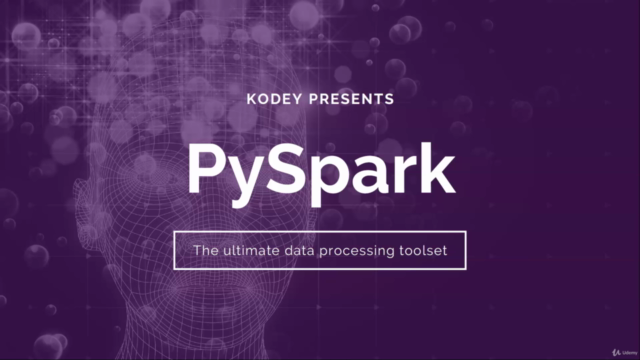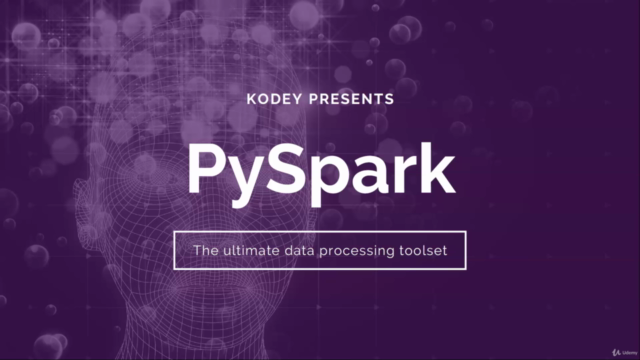A Crash Course In PySpark

Why take this course?
🚀 A Crash Course in PySpark 🎓
Course Instructor: Kieran Keene
Headline: Dive into the World of Big Data with PySpark!
Course Description:
Are you ready to unlock the power of Big Data? A Crash Course in PySpark is your gateway to mastering one of the most sought-after skills in data processing. Spark, a unified engine for large-scale data analytics, is at the forefront of the industry, and with PySpark—its Python API—you can perform complex data analysis programmatically with ease.
Why PySpark?
- Flexibility: It allows you to write code in Python, a language familiar to many data scientists.
- Scalability: Spark can handle enormous datasets that are beyond the scope of traditional tools.
- Performance: Process data faster than ever before with Spark's in-memory processing capabilities.
- Accessibility: With PySpark, you can leverage your existing Python and SQL knowledge to perform complex operations.
What You Will Learn:
- 🔗 Data Acquisition: Discover how to easily access, load, and read data from various sources like CSVs, JSONs, and databases.
- ➡️ Data Cleaning: Get to grips with handling missing values, cleaning up your datasets, and ensuring the integrity of your data.
- 📊 Data Aggregation: Learn how to perform complex aggregations to transform your data into meaningful insights.
- 🔄 Data Filtering: Master the art of filtering your data with ease using PySpark's DataFrame capabilities.
- ⫫ Data Pivoting: Pivot your data to understand different perspectives and gain deeper insights.
- 🗃️ Data Writing: Export your processed data back to files, databases, or other systems, ready for real-world applications.
Course Outline:
- PySpark Basics: Understanding PySpark's architecture and installing the necessary libraries.
- Core PySpark Concepts: Exploring Spark SQL, DataFrames, and RDDs.
- Data Ingestion and Processing: Techniques for loading data from various sources and processing it within PySpark.
- Data Cleaning and Preparation: Effective strategies for cleaning, transforming, and preparing your datasets.
- Data Aggregation and Analysis: Performing complex aggregations to extract meaningful insights.
- Data Filtering and Selection: Using Spark SQL queries to filter and select the data you need.
- Data Pivoting and Transformation: Understanding how to pivot data to analyze it from different angles.
- Writing Data Back: Exporting your processed data into files, databases, or other systems.
- Real-World Applications: Applying PySpark to solve real-world problems in various industries.
Who Is This Course For?
This course is designed for:
- Aspiring data scientists who want to understand Big Data processing with Spark.
- Developers looking to add PySpark to their toolkit.
- Professionals in analytics, finance, or any field that requires handling large datasets.
- Anyone interested in leveraging the power of distributed computing for data analysis.
Join Us on This Adventure!
Embark on a journey to becoming a PySpark expert. With hands-on examples, interactive exercises, and clear explanations, you'll be able to apply what you learn directly to your work.
Enroll in A Crash Course in PySpark today and take your first step towards mastering Big Data! 🌟
Course Gallery




Loading charts...
Comidoc Review
Our Verdict
A Crash Course In PySpark offers a quick introduction for beginners and covers essential foundational topics in an hour and a half. Despite the minor shortcomings, such as limited exploration of advanced concepts or real-world applications, it provides a well-structured base that learners can build upon and progress confidently into more complex subjects.
What We Liked
- Covers fundamental PySpark concepts in a concise and beginner-friendly manner
- Hands-on approach allowing practice alongside the course
- Clear explanations of each step and function, making it easy to reproduce and remember
- Inspires confidence in new learners with its strong foundational guidance
Potential Drawbacks
- Lacks detailed discussion on Spark architecture and distributed storage
- Could benefit from discussing real-world applications of PySpark
- Minimal coverage of how PySpark integrates into tech stacks and common pipelines
- Occasional inaccuracies and lack of attention to detail (e.g., use of incorrect gender terminology)